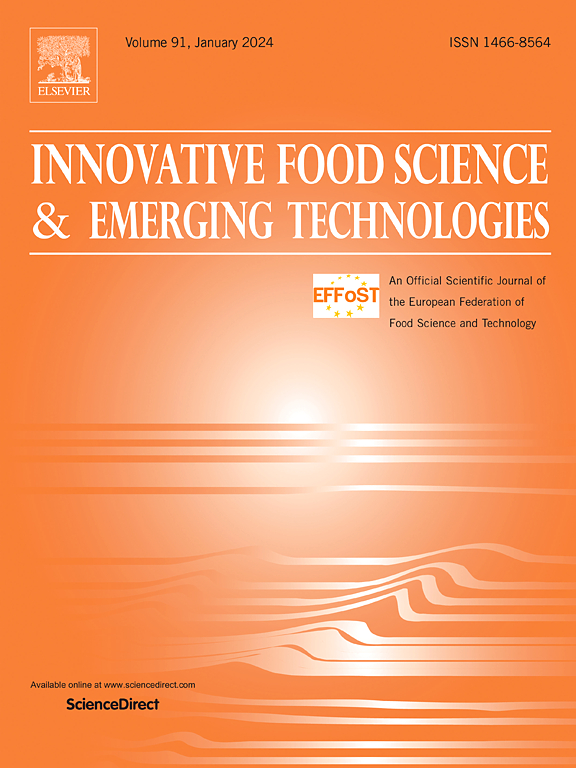利用甘氨酸包被氧化锌纳米颗粒制备具有靶向抗菌活性的等离子体聚合纳米复合涂层
IF 6.8
1区 农林科学
Q1 FOOD SCIENCE & TECHNOLOGY
Innovative Food Science & Emerging Technologies
Pub Date : 2025-06-21
DOI:10.1016/j.ifset.2025.104091
引用次数: 0
摘要
设计具有目标抗菌活性的可持续食品包装材料是延长食品保质期同时最大限度地减少环境污染的一种有前途的方法。本研究采用绿色、常压、气溶胶辅助等离子沉积(AAPD)技术,开发了基于聚乙二醇(PEG)和甘氨酸(Gly)包被氧化锌纳米粒子(ZnO NPs)的纳米复合涂层,旨在获得靶向抗菌活性。结果表明,当gly包覆ZnO NPs的用量达到2%时,gly包覆ZnO NPs可以均匀地分散到PEG基体中,形成具有结构良好的纳米级粗糙度的均匀涂层。相反,使用未涂覆的ZnO NPs会导致非均匀涂层,并增强NP团聚。所开发的纳米复合涂层与传统PEG聚合物的化学结构非常相似,并表现出增强的亲水性,特别是gly包覆ZnO NPs的涂层。此外,gly包被的ZnO NPs对金黄色葡萄球菌(革兰氏阳性)具有更强的活性,而未包被的ZnO NPs对大肠杆菌(革兰氏阴性)具有更强的活性。在不同的食品模拟剂中,镀层中锌离子的释放量均低于特定迁移限值。为评价单增李斯特菌(L. monocytogenes)和乳酸菌(LAB)组合接种的无菌猪肉香肠在实际食品中的抑菌活性,将其包裹在涂有PEG/ZnO的聚乙烯(PE)薄膜中,真空密封,然后在7℃下保存,评估细菌的生长情况。纳米复合涂层,特别是含有gly包覆ZnO NPs的纳米复合涂层,在储存期间有效地抑制了细菌的生长。总的来说,新型纳米复合涂层显示出作为食品储存高效靶向抗菌涂层的潜力。本文章由计算机程序翻译,如有差异,请以英文原文为准。

Development of plasma-polymerized nanocomposite coatings with targeted antimicrobial activity utilizing glycine-coated ZnO nanoparticles
Designing sustainable food packaging materials with targeted antimicrobial activity is a promising approach to extend food shelf life while minimizing environmental pollution. This study employs a green, atmospheric pressure, aerosol-assisted plasma deposition (AAPD) to develop nanocomposite coatings based on polyethylene glycol (PEG) and glycine (Gly)-coated zinc oxide nanoparticles (ZnO NPs), aiming for targeted antimicrobial activity. The results indicate that Gly-coated ZnO NPs can be homogeneously dispersed into the PEG matrix, forming uniform coatings with a well-structured nanoscale roughness, when using up to 2 wt% of Gly-coated ZnO NPs. In contrast, using uncoated ZnO NPs leads to non-homogeneous coatings with enhanced NP agglomeration. The developed nanocomposite coatings closely resemble the chemical structure of conventional PEG polymers and exhibit enhanced hydrophilic characteristics, particularly the coatings with Gly-coated ZnO NPs. Furthermore, the Gly-coated ZnO NPs exhibited stronger activity against S. aureus (Gram-positive), whereas uncoated ZnO NPs were more potent against E. coli (Gram-negative). The release of Zn ions from the coatings in different food simulants was below the specific migration limit. To evaluate the antibacterial activity when exposed to actual food products, sterilized pork sausages inoculated with a combination of Listeria monocytogenes (L. monocytogenes) and Lactic Acid Bacteria (LAB) strains were wrapped in the polyethylene (PE) film coated with PEG/ZnO and sealed in vacuum packaging, after which the growth of bacteriawas evaluated while stored at 7 °C. The nanocomposite coatings, particularly those containing Gly-coated ZnO NPs, effectively inhibited bacterial growth during storage time. Overall, novel nanocomposite coatings indicate potential as efficient targeted antimicrobial coatings for food storage.
求助全文
通过发布文献求助,成功后即可免费获取论文全文。
去求助
来源期刊
CiteScore
12.00
自引率
6.10%
发文量
259
审稿时长
25 days
期刊介绍:
Innovative Food Science and Emerging Technologies (IFSET) aims to provide the highest quality original contributions and few, mainly upon invitation, reviews on and highly innovative developments in food science and emerging food process technologies. The significance of the results either for the science community or for industrial R&D groups must be specified. Papers submitted must be of highest scientific quality and only those advancing current scientific knowledge and understanding or with technical relevance will be considered.

 求助内容:
求助内容: 应助结果提醒方式:
应助结果提醒方式:


